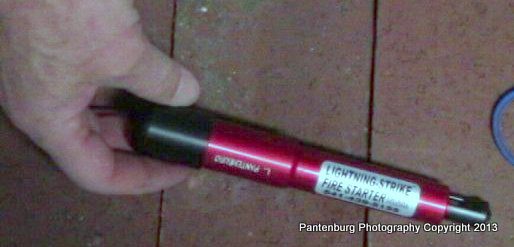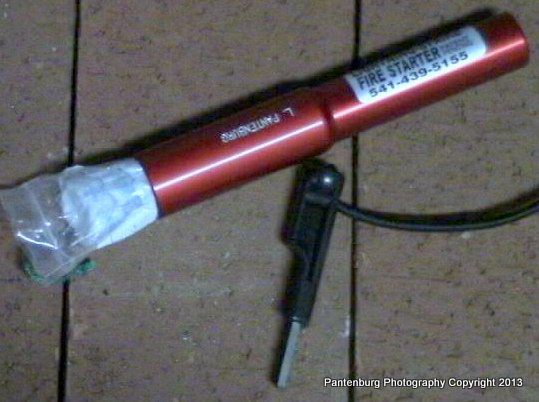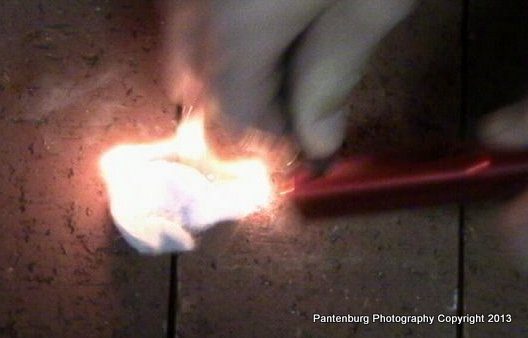At the time of this publication, Lightning-Strike Fire Starter is not an advertiser with SurvivalCommonSense.com. I was not reimbursed for this review.
During a backcountry emergency, you may stake your life on your firemaking tools. Here is a system worth considering.
by Leon Pantenburg
It has been well over 12 years, and thousands of fires, since I used anything but traditional flint, steel and charcloth to start a campfire in the wilderness: I enjoy practicing survival skills.
 The Lightning-Strike is compact, portable and contains a complete firemaking system.
The Lightning-Strike is compact, portable and contains a complete firemaking system.As a Boy Scout and community volunteer, I have done extensive research on what survival firemaking tools and techniques work best. In the past 12 years, I have helped teach well over 12,000 scouts, students, outdoorspeople and others the flint and steel technique. In 2007, I received a Boy Scouts Fremont District Award of Merit for the survival firemaking teaching program I designed and helped implement.
The point of this bragging is that I can claim some expertise in survival firemaking. Typically, SurvivalCommonSense doesn't do fire tool reviews, because, many of the "new" products are nothing but re-organized and re-packaged versions of the same old techniques and tools. And it would be really, really hard to improve upon my go-to survival firestarting standard of cotton balls infused with petroleum jelly, ignited with a ferrocerium rod.
So Darrell Holland, inventor of the Lightning-Strike Fire Starter, had a sales job before I would agree to review the product. The product came into existence after Holland and his son, an Eagle Scout decided to come up with a new and improved firestarting tool.
 The Lightning-Strike contains firestarter in the handle, and disassembles to allow the ferrocerium rod to be used with the striker.
The Lightning-Strike contains firestarter in the handle, and disassembles to allow the ferrocerium rod to be used with the striker.Here are the advantages of the Lightning-Strike, according to Holland.
- Completely self-contained: A Lightning-Strike is light (about 8 ounces) compact and easy to pack. It provides everything you need to start an emergency fire.
- Waterproof: The Lightning-Strike Tinder is kept in a waterproof container that also serves as the handle.
- Hotter sparks: The sparks produced by the ferrocerium rod in the unit are between 4,000 and 5,000 degrees, according to the company, and the focused stream makes for better and faster ignition.
- Works in any environmental situation.
If all that was true, then this method did have something new and different.
In my experience, a common problem with survival firestarting is making the transition from ignition to smaller twigs. Generally, most people can light a match or lighter to produce the initial flame. Where they fail is lack of transition time, which would allow the flame to light the twigs or other tinder.
A match may be good for a few seconds of flame, and a lighter for longer. But during nasty, rainy weather, if the wood is wet or damp, that may not be enough time. I always carry emergency firestarter along just because of that. In a survival situation where hypothermia is a possibility, time is critical.
My first impression of the Lightning-Strike out of the box is that it shows quality materials and workmanship. About the size of a mini-maglite, it doesn't take up much room. The ferrocerium rod throws showers of sparks, and it is positioned in a tube that concentrates them. This makes for a much hotter ignition.
 The ferro rod readily ignites the firestarter that is stored in the hollow handle.
The ferro rod readily ignites the firestarter that is stored in the hollow handle.I was amazed - my old reliable ferro rod that I have been carrying for a couple years only appeared to be about half as bright as the Lightning-Strike. I'm assuming this means the Lightning-Strike produces about twice the heat.
A special firestarter comes with the Lightning-Strike, and it is designed to fit in the handle. The material appears to be some sort of petroleum product, that is infused into a cotton (?) pad. The firestarter can be ordered from the company. My thought is to continue carrying a separate container of cotton balls and petroleum jelly, and use that first.
And the system can be used one-handed. All you do is remove the firestarter from the handle, and position it at the end of the tube. Stand on the end of the Lightning-Strike to hold it in place, and scrape the ferro rod with the striker. Fire.
All in all, I really like the Lightning-Strike. It seems eminently practical, and it produces a hot spark stream that lights tinders quite well. The quality workmanship means the product should be reliable, and pretty much foolproof. A Lightning-Strike could be a valuable addition to a bug out bag, daypack or any other emergency/survival kit. This product is a keeper.
No comments:
Post a Comment